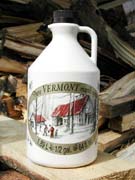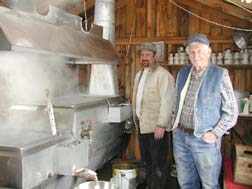|
 |
Burton on the Bay
by Bill Burton |
The Sap is Rising
Baby, it’s cold outside.
—From a popular song of the ’40s.
Baby, it might have been cold outside, but it wasn’t in the sugar shack behind Roy Crofut’s house in West Arlington, Vermont, where the fire was stoked up to maximum and the maple sap was bubbling atop the flames.
It was sugaring time in Vermont, and I journeyed north to re-live the past, like when school mate Spike Campbell and I took on the job of helping turn the sap from the maples into syrup that when poured on pancakes and waffles makes them a gourmet’s delight.
Lucky Spike, he got to tend the fire in the shack in Arlington; me, I was assigned the task of unloading the sap from a tank outside where it was windy and cold. I sneaked inside more than a few times, and not just for warmth. The delightfully sweet aroma of sap over a fire is something one never forgets, and even today I could have stayed in Roy’s tiny shack on the shores of the Battenkill, known for its trout, until the fishing season starts in a couple of months. However, my companion, Alan Doelp of Linthicum, had to get back to Baltimore.
He had accompanied me to see Vermont at mud time and to see how maple syrup was made. Last year, there was mud when we made the pilgrimage, but sugaring was late. This time there was no mud, but the sap was running. When the sap flows in the trees, about 2,000 Vermonters like Roy Crofut and his son Glen are mighty busy.
From Table to Luxury Sweet
In sugaring, you’ve got to strike while the iron is hot — or when the sap flows. It flows best when nights are cold and days are warm. Snooze and you lose. With top syrup selling retail at $35 to $45 a gallon, there’s much to lose, and that includes the delight of enjoying your own sap on flapjacks.
 Roy is a typical Vermonter. For more than 25 years he’s been tapping enough trees to make 40, maybe 50 gallons of syrup. The big-time operations make thousands of gallons, and Vermont tops the nation for maple syrup — though Quebec produces five million gallons, 10 times that of my Green Mountain State. Roy is a typical Vermonter. For more than 25 years he’s been tapping enough trees to make 40, maybe 50 gallons of syrup. The big-time operations make thousands of gallons, and Vermont tops the nation for maple syrup — though Quebec produces five million gallons, 10 times that of my Green Mountain State.
As usual, once again I neglected to try tapping the red and silver maples in my yard in North County. Though they’re not sugar maples, they can turn out sap for syrup, although it isn’t nearly as sweet. The country boy in me makes me want to try, but I keep forgetting sap runs appreciably earlier in Maryland than in my old home state. So I returned to Vermont, king of the nation’s syrup industry.
This year, the sap is running two percent, Roy told me. That’s the percentage of sugar in the sap; it’d be better closer to three percent. The difference means more sap to get the same amount of syrup. Syrup is the big item these days. Who would think that back in 1880, maple sugar (sap boiled down from liquid state) was selling for the same price as imported regular white cane sugar.
 |
| Roy Crofut and his son Glen boiling down sap into maple syrup. |
Hard to believe but true. In many a household, sugar bowls back then had the light brown product of the maple for sweetening cereal, baked goods and just about anything else. Uncle Larry Brush’s not-so-secret ingredient in mixed drinks was a tad of syrup or sugar, especially in the old fashioneds he was known for.
In the past 50 years, syrup is the prime target of those who tap the trees. To get a gallon of syrup, it takes 40 to 45 gallons of sap, depending on the sugar content. Bottom line, a good tree’s eventual yield could be a half gallon of syrup, though a quart or a bit more ain’t bad.
My hope is that one of these days, before my maple trees start sprouting for leaves, I’ll tap my three trees the old-fashioned way with the sap leaking into buckets. That’s pretty much like it was when Spike and I sugared that weekend about 60 years ago. I intend to boil the sap over my kitchen range. Back then it was over a wood stove.
Today, it’s so much different with the big operations. Oil-fed heaters can make syrup from sap in an hour or less, and there are vacuum pumps and reverse osmosis techniques to get more sap from the trees. I recall when draft horses were about the only means to carry the syrup from the woods, and that was on sleds. No more. In the woods now, one sees a tangle of tubes. The buckets are long gone. Now the sap runs directly from trees to tanks via tubing.
Grades of Satisfaction
Roy Crofut has 233 taps drawing syrup this year, and all is going well, though there’s always the possible problem, like when coyotes chew on the tubes. A ruptured hose means sap wasted on the ground. “You know, puppy coyotes like the play and will chew on anything,” said Roy philosophically as he skimmed the boiling sap.
In the sugar house were several small jars, each with varying shades of syrup. The most light and clear was fancy grade. At the other end was the slightly amber, said by some to have a more hearty, syrupy flavor — though sometimes I think people brag about the taste of the amber to avoid admitting they’re cheapskates. The syrup Roy was skimming was shaping up light and clear, sure to be fancy.
Vermont is persnickety about its syrup marketing; no additives, and it must be graded precisely. If not, you don’t get the state’s seal of approval. Most syrups you see in stores hereabouts wouldn’t get the seal; they’re just flavored with the real stuff. If I ever get around to tapping my trees here, the only seal I’ll get is one of my own personal approval, for the satisfaction of producing my own syrup.
to the top
|
|


 Roy is a typical Vermonter. For more than 25 years he’s been tapping enough trees to make 40, maybe 50 gallons of syrup. The big-time operations make thousands of gallons, and Vermont tops the nation for maple syrup — though Quebec produces five million gallons, 10 times that of my Green Mountain State.
Roy is a typical Vermonter. For more than 25 years he’s been tapping enough trees to make 40, maybe 50 gallons of syrup. The big-time operations make thousands of gallons, and Vermont tops the nation for maple syrup — though Quebec produces five million gallons, 10 times that of my Green Mountain State.